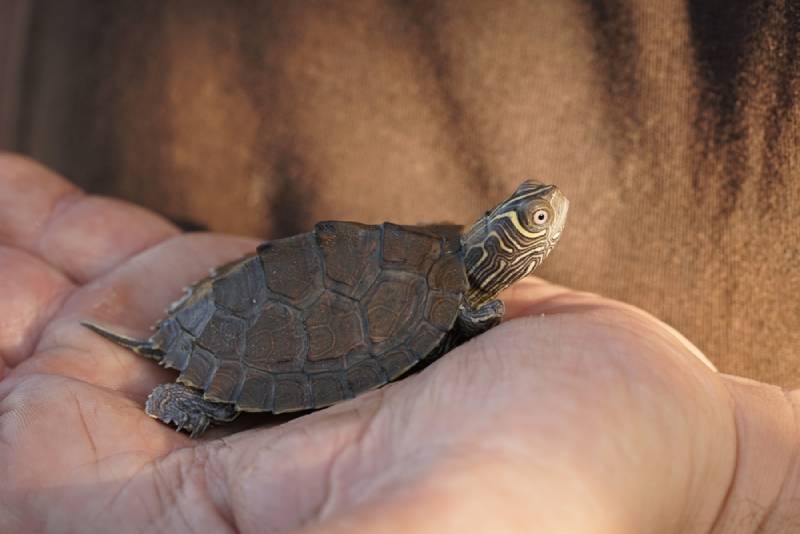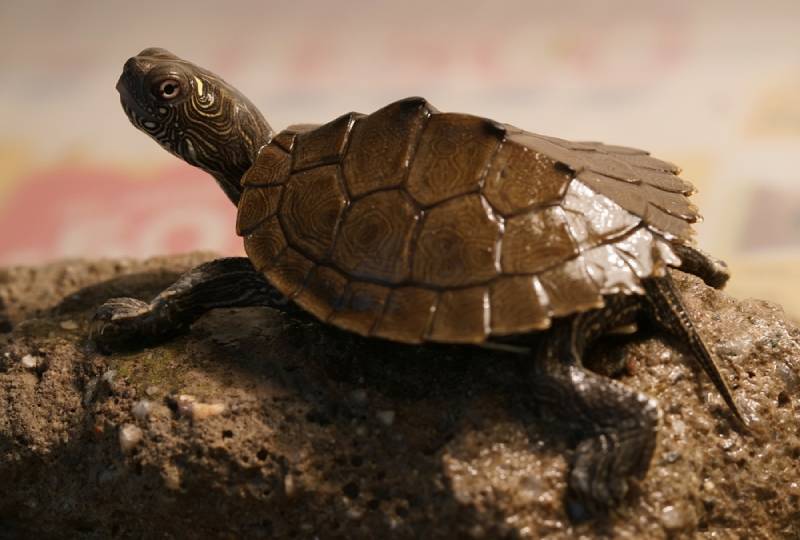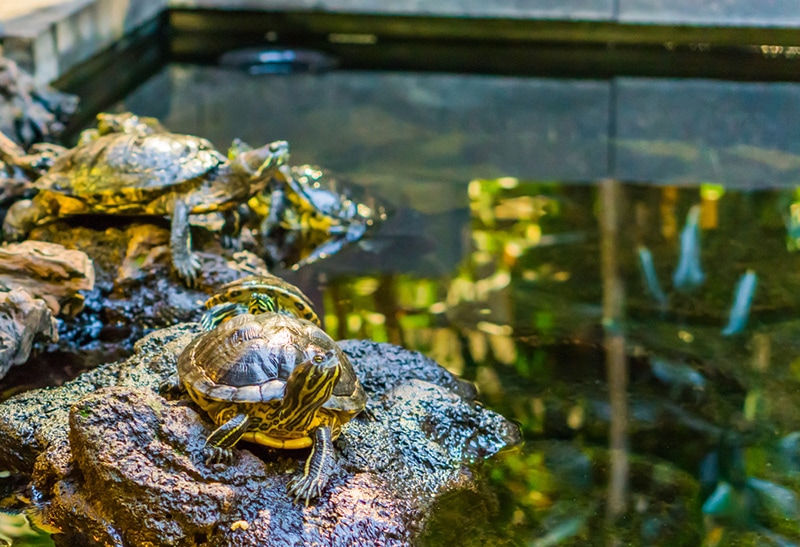Mississippi Map Turtle: Facts, Pictures, Diet & Care Guide

Updated on

With its intricate shell patterns resembling maps and its fascinating behavior, the Mississippi Map Turtle has earned a special place in the hearts of reptile enthusiasts worldwide.
With their fascinating profile among their fellow map turtles, there is much to know about the Mississippi Map Turtle. Here, we will explore the characteristics, behavior, tank requirements, and everything you need to know about this beautiful and unique species. Whether you’re considering adopting a Mississippi Map Turtle or simply curious about these intriguing creatures, read on to uncover the wonders of this remarkable reptile!
| Size: | 8 to 10 inches for females, 5 to 7 inches for males |
| Weight: | 1 to 5 pounds |
| Lifespan: | Over 30 years |
| Suitable for: | Experienced turtle enthusiasts |
| Temperament: | Shy and sociable for turtles, Females can be dominant |
The Mississippi Map Turtle, scientifically known as Graptemys pseudogeographica kohni, is a subspecies of the widely distributed Map Turtle family. They are native to the southeastern United States, particularly the Mississippi River and its surrounding watersheds. This breed’s most distinctive feature is the map-like markings on its upper shell, which give it its name. The patterns vary by individual, making each turtle unique.
Historically, Mississippi Map Turtles were abundant in the wild, but due to habitat loss and over-collection, they have become less common in recent years. As for breeding, these turtles usually mate in early spring. Females seek out sandy areas along riverbanks to lay their eggs, usually producing clutches of 5 to 20 eggs. Incubation lasts about 70 to 90 days, and hatchlings emerge in late summer. Proper care and conservation efforts are crucial to ensure the survival of this species.
Mississippi Map Turtle Breed Characteristics
How Much Do These Turtles Cost?
Finding a Mississippi Map Turtle for sale can be a bit challenging due to their declining numbers in the wild. It is essential to avoid purchasing turtles caught from the wild to prevent further depletion of their populations and support responsible breeding practices. Reputable breeders and specialized exotic pet stores are the best places to find healthy captive-bred individuals.
Because of their rarity and unique appearance, Mississippi Map Turtles can be relatively expensive compared to more common turtle species. Prices vary depending on factors like age, size, and the breeder’s reputation, but expect to pay anywhere from $50 to $200 for a hatchling or young turtle.

Mississippi Map Turtle Behavior
Mississippi Map Turtles are known for their active and aquatic behavior. These turtles are diurnal, meaning they are most active during the day. They are skilled swimmers and spend the majority of their time in the water. When they bask, they prefer to do so on logs or rocks partially submerged in the water, allowing them to retreat quickly if they feel threatened.
Despite their wild nature, some individuals can become relatively tolerant of human presence through proper socialization and regular interaction. However, it is essential to remember that they still require ample space and a well-maintained environment to thrive.
Do These Turtles Make Good Pets?👪
Keeping a Mississippi Map Turtle as a pet can be rewarding for experienced reptile keepers. Take note, however, that potential owners should be aware of the commitment and responsibility involved. These turtles have specific habitat requirements and can live for several decades, so owning one is a long-term commitment.
They may not be as affectionate as a dog or a cat, but they do exhibit intriguing behaviors and personalities that can be fascinating to observe. Mississippi Map Turtles are easily susceptible to stress, so interaction with humans should be limited to feeding, cleaning, and general observation. Because of the special care needed, they are recommended for more experienced turtle owners.
Mississippi Map Turtle Tank Mates
When setting up a tank for a Mississippi Map Turtle, it’s essential to consider compatible tank mates. Although turtles are generally considered solitary creatures, Mississippi Map Turtles are social as a species and can be seen basking as a community in the wild. Females, however, tend to be more dominant and aggressive as they mature so it’s best to keep the number of females to a minimum.
Regardless, always monitor the interactions between your turtle and tank mates to ensure everyone is thriving and there are no signs of aggression or stress.
Care Sheet & Habitat Setup:
Light Requirements
Proper lighting is crucial for the health and well-being of Mississippi Map Turtles. In their natural habitat, they bask in sunlight to regulate their body temperature and obtain essential vitamins, such as vitamin D3, which is necessary for calcium absorption.
In a captive setting, providing full-spectrum UVB lighting is essential. UVB light enables the synthesis of vitamin D3 in the turtle’s skin, which, in turn, helps them metabolize calcium. A lack of adequate UVB lighting can lead to serious health issues, such as metabolic bone disease, a common condition in reptiles with insufficient access to UVB.
Tank Size
As Mississippi Map Turtles are semi-aquatic and enjoy swimming, a spacious tank is essential for their well-being. The tank size will depend on the turtle’s age and size, but as a general rule, the enclosure should be at least 3 times the length of the turtle’s shell. For a hatchling or juvenile turtle, a 40-gallon tank is a good starting point, but as they grow, you may need to upgrade to a larger enclosure.
A larger tank not only allows the turtle to swim freely but also provides space for a designated basking area with access to UVB and heat lamps. Ensure that the enclosure has a secure lid to prevent escapes!

Water Temperature
Maintaining proper water temperature is crucial for the health and activity level of Mississippi Map Turtles. The water should be kept between 75°F to 80°F (24°C to 27°C) for the overall well-being of the turtle. Use a reliable aquarium heater and a thermometer to monitor and maintain the water temperature consistently.
In addition to the water temperature, provide a basking area with a temperature ranging from 85°F to 90°F (29°C to 32°C) to allow the turtle to warm up and dry off completely. This basking spot is essential for thermoregulation and ensuring that the turtle can properly digest its food.
Plants
Including live aquatic plants in the tank offers several benefits for Mississippi Map Turtles. First, they provide additional hiding spots and enrichment opportunities, encouraging the turtles to explore and interact with their environment. Secondly, the plants help maintain water quality by absorbing excess nutrients and reducing algae growth.
Choose hardy aquatic plant species that can tolerate the conditions of a turtle tank. Some suitable options include water lettuce, water hyacinth, hornwort, anacharis, and java fern.
Substrate
For the tank’s substrate, a fine sand or gravel mix works well for Mississippi Map Turtles. This substrate not only creates a natural environment but also allows the turtles to dig and bury their eggs if you plan on breeding them. Remember to regularly clean the substrate to maintain water quality, as uneaten food and waste can accumulate in the substrate over time.
Filtration
Maintaining proper water quality is essential for the health of your Mississippi Map Turtle. A reliable filtration system is necessary to remove waste and toxins from the water. A combination of mechanical, biological, and chemical filtration will help keep the water clean and clear.
A good filtration system will also reduce the frequency of water changes, making tank maintenance more manageable. Be sure to follow the manufacturer’s guidelines for the filter’s maintenance and cleaning schedule to keep it running efficiently.
Things to Know When Owning a Mississippi Map Turtle:
Food & Diet Requirements🥕
As omnivores, Mississippi Map Turtles have a diverse diet that includes aquatic plants, insects, small fish, and crustaceans. Providing a well-balanced and varied diet is crucial for their overall health.
Commercial turtle pellets can form the base of their diet, but they should be supplemented with fresh vegetables, such as leafy greens, carrots, and zucchini. Additionally, offer occasional protein-rich treats, such as earthworms, crickets, and small feeder fish.
Younger turtles will have a higher proportion of animal protein in their diet, while older individuals can have a more plant-based diet. Always ensure that the food is appropriate in size for the turtle to avoid choking hazards.

Size & Growth Chart
Mississippi Map Turtles grow at a moderate rate and can reach an average size of 5 to 10 inches (12 to 25 cm) in length. Males are generally smaller than females, with males reaching around 5 to 7 inches (12 to 18 cm) and females growing up to 8 to 10 inches (20 to 25 cm).
Lifespan and Health Conditions 🏥
In a well-maintained captive environment, Mississippi Map Turtles can live for several decades, with most of them living for over 30 years. With proper care and attention, they can thrive and provide you with enjoyment for many years.
- Metabolic Bone Disease
- Respiratory Infections
- Shell Rot
- Shell Erosion
- Eye Infections
Male vs Female
When it comes to the Mississippi Map Turtle, there are many things to consider when owning males and females. As mentioned earlier, females tend to grow larger than males and can also be more aggressive and dominant compared to males.
Males also have longer and thicker tails than females, while females tend to have wider and rounder shells. Additionally, males often display more vibrant coloration and patterns on their skin and shell.
3 Little-Known Facts About Mississippi Map Turtle
Mississippi Map Turtles showcase their aquatic prowess as remarkable swimmers and navigators. Their streamlined bodies and webbed feet allow them to effortlessly glide through the water, exhibiting agile movements. They possess an incredible ability to detect and utilize natural currents, enabling them to float downstream for miles without expending much energy. This unique skill also aids them in finding their way back to their home territory even after being relocated to a different area.
2. Social Greetings
When encountering other turtles, they often extend their limbs and heads in a gentle “wave-like” motion. This intriguing behavior serves as a form of communication, allowing them to convey their intentions and establish social interactions. While it can be a display of peaceful acknowledgment, it can also serve as territorial or courtship behavior. This social greeting highlights their capacity for subtle communication within their species, providing insight into their social dynamics and innate behaviors that contribute to the richness of their interactions in the wild.
3. Harmonious Basking
Mississippi Map Turtles exhibit a harmonious behavior while basking together on logs or rocks partially submerged in the water. When multiple turtles share a basking spot, they tend to align their bodies parallel to each other, showcasing a sense of togetherness and cohabitation. This behavior not only allows them to optimize their basking experience but also signifies a level of camaraderie within their turtle community.
Final Thoughts
The Mississippi Map Turtle is undeniably a fascinating and captivating species, offering unique traits and behavior that make them a delight to observe. If you’re an experienced reptile keeper with dedication to provide proper care and a suitable environment, having a Mississippi Map Turtle as a pet can be an enriching experience.
However, due to their declining numbers in the wild, it’s crucial to support conservation efforts and responsible breeding practices to ensure the survival of this remarkable breed for generations to come. By educating ourselves and others about the importance of protecting these turtles and their natural habitats, we can contribute to their preservation and cherish the wonders of the Mississippi Map Turtle for years to come!
Featured Image Credit to: Ken Schulze, Shutterstock










